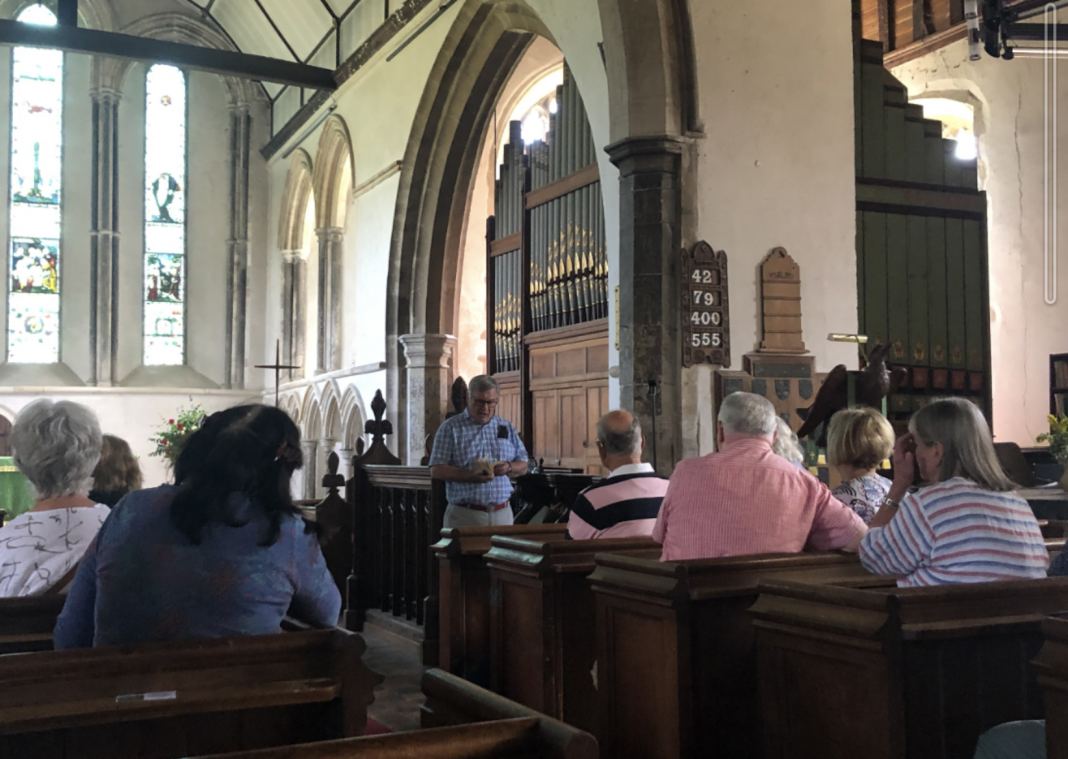The first Saturday in July saw almost thirty Friends of St Mary’s gathered at Rye’s Station Approach to board Rye Community Transport buses for an afternoon visiting two churches and taking tea. This was a welcome return to an annual event, which, because of Covid, had not been held since 2019. In bright sunshine, our outward route passed Fairfield church, before the first stop at Snargate.
When Snargate church was built in the early 1200s, the surrounding land was marshy, providing summer grazing, which flooded at high tides. Contemporary writers described “bad airs” and an unhealthy environment.
In early Norman times, the river Rother flowed south from around the Isle of Oxney, along a long curve south of Snargate towards Rye before swinging to the west past Old Romney and then to the sea at the port of New Romney.
From the late 1100s, the Archbishop of Canterbury who owned much land around, was reclaiming the marsh between a line from Appledore and Romney into what is now Walland Marsh. The plan was to drain the land to meet demand from those who lived in woodland to the north of the marsh where agricultural land was in short supply.
While the reclamation work (called “inning”) was under way in the 1200s, the people of Romney embarked on a massive piece of civil engineering. The “Rhee Wall” and “Yoke Sluice” was dug for over seven miles to enable the silting channel of the Rother to continue to flow to the sea near present day New Romney.
There was a sluice at Snargate and another near the Old Romney church. The concept was to catch the tidal waters as they rose from Romney to Appledore, hold them until the tide fell and then to release them into the harbour. This flushing mechanism was made redundant after 1287, when a violent storm closed Romney’s port and the Rother diverted naturally to the sea at Rye. The man made canal was then abandoned to become the raised dyke on which the Appledore to Romney road now runs.
Snargate church was built to serve the community which grew up around the sluice. Dedicated to St Dunstan (Archbishop of Canterbury in the late 900s), there is a 14th century portrait of him on a glass remnant in the south chapel.
Building started around 1200 in the early English style. Remnants of the early church include a plain square font, with its contemporary base from around 1220. The 16th century nave roof is magnificent, with tie beams and king posts. There are lots of detailed features reflecting the social and religious changes over the centuries. In several places there are signs of medieval wall painting and graffiti that was hidden by whitewashing in the mid 1500s. One feature is the image of a large ship (a carrack) discovered about 30 years ago in the north aisle. This probably dates from the 1500s. It is not clear whether this was a reflection of the nearby shipbuilding yards on the Isle of Oxney, or a signal to smugglers that the church was a safe haven? We know that In 1743, the customs men made a large seizure of tobacco and Dutch gin in the church.
Some of the smuggler and folklore tales were set down as stories and poems in the 1820s as the “Ingoldsby Legends”, written by the then rector, Reverend Richard Barham. These were very popular in Victorian times.
After Snargate, the party went on to Woodchurch. This would have been one of the communities in the woods from where there was medieval demand for agricultural land on the marsh. The large village, with its picturesque green, is on high ground with oaken coppice wood around. Woodchurch is above the “upper levels” of Appledore, Ebony, and Tenterden which drain to the river Rother flowing through Scots-float and onto Rye harbour.
Woodchurch was formerly Thunland, or Townland, becoming firmly established in the 13th century with the building of All Saints, a big church made of Kentish ragstone. Although much restored in the 1840s, it boasts a 13th-century chancel and brasses from the 14th century. The pillars in the nave show signs of dark colouration, resulting from an experiment by a Victorian rector who preferred marble to sandstone!
In the south chancel there is a tomb, of Bethersden marble, for Sir Edward Waterhouse, chancellor of the exchequer for Ireland (1591) and privy counsellor to Queen Elizabeth the first.
On the tower, there is an unusual four-faced clock, allowing time to be seen throughout the village and a spire that is 18 inches out of the vertical.
After Woodchurch, there was some anticipation of the renowned Women’s Institute tea in Stone in Oxney. After that, a relatively subdued party completed the return via the Military Canal to Rye.
Image Credits: Anthony Kimber .



